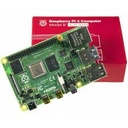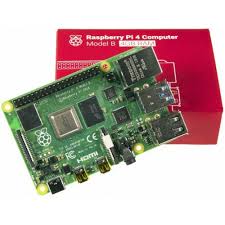Raspberry pi 4(4GB RAM)
This content will be shared across all product pages.
The Raspberry Pi 4 Model B is a versatile single-board computer (SBC) developed by the Raspberry Pi Foundation. It offers significant improvements over its predecessors, including increased performance, enhanced multimedia capabilities, and expanded connectivity options. The 4GB RAM variant is ideal for various projects requiring more memory for multitasking and resource-intensive applications.
Key Features:
- Broadcom BCM2711, Quad-core Cortex-A72 (ARM v8) 64-bit SoC @ 1.5GHz
- 4GB LPDDR4-3200 SDRAM
- Dual-band 802.11ac wireless networking
- Gigabit Ethernet
- Bluetooth 5.0
- 2 × USB 3.0 ports, 2 × USB 2.0 ports
- 2 × micro HDMI ports supporting up to 4Kp60 resolution
- MIPI DSI display port, MIPI CSI camera port, 4-pole stereo audio and composite video port
- MicroSD card slot for operating system and data storage
- 40-pin GPIO header
- Power-over-Ethernet (PoE) support (requires separate PoE HAT)
- Processor: Broadcom BCM2711, Quad-core Cortex-A72 (ARM v8) 64-bit SoC @ 1.5GHz
- RAM: 4GB LPDDR4-3200 SDRAM
- Wireless: Dual-band 802.11ac wireless LAN and Bluetooth 5.0
- Video Output: 2 × micro HDMI ports supporting up to 4Kp60 resolution
- USB: 2 × USB 3.0 ports, 2 × USB 2.0 ports
- Ethernet: Gigabit Ethernet
- GPIO: 40-pin GPIO header
- Operating System: Supports various Linux distributions, including Raspberry Pi OS (formerly Raspbian)
- Power Requirement: 5V DC via USB-C connector
- Dimensions: 85.6mm × 56.5mm × 17mm
- DIY projects
- Robotics
- IoT (Internet of Things) applications
- Multimedia streaming and playback
- Desktop computer replacement
Technical Specifications:
- Logic Family: CMOS
- Number of Channels: 3
- Switch Configuration: Single-Pole Double-Throw (SPDT)
- Supply Voltage Range: 3V to 15V
- “ON” Resistance (R_ON): 125Ω typical at V_DD = 10V
- “OFF” Leakage Current (I_OFF): ±100pA typical at V_DD = 10V
- Control Input Voltage (V_IH): 0.7 V_DD min, 0.3 V_DD max
- Maximum Operating Frequency: 40 MHz at V_DD = 10V
Applications:
- Signal routing and switching
- Analog and digital multiplexing
- Audio and video signal processing
- Data acquisition systems
- Test equipment


